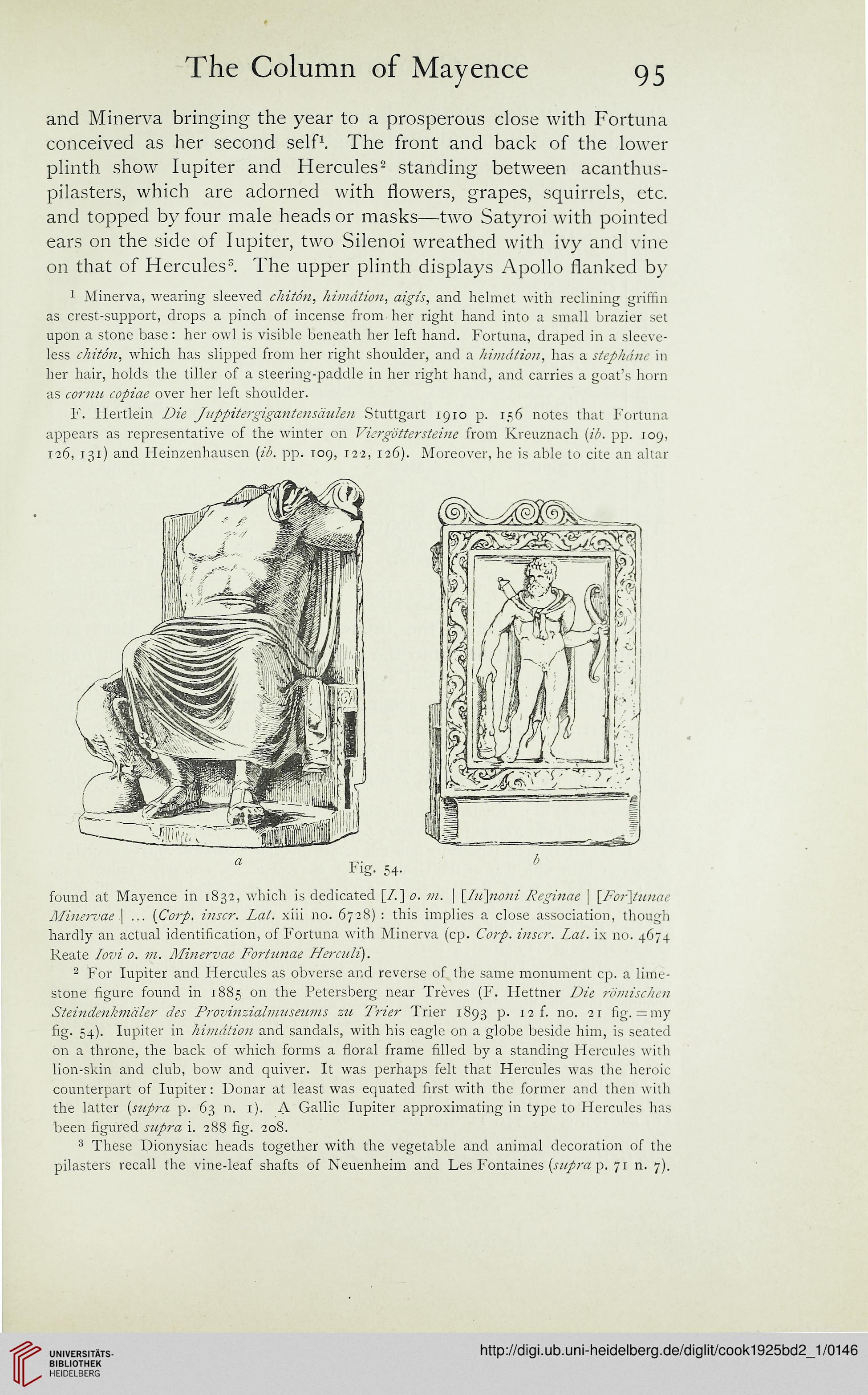The Column of Mayence 95
and Minerva bringing the year to a prosperous close with Fortuna
conceived as her second self1. The front and back of the lower
plinth show Iupiter and Hercules2 standing between acanthus-
pilasters, which are adorned with flowers, grapes, squirrels, etc.
and topped by four male heads or masks—two Satyroi with pointed
ears on the side of Iupiter, two Silenoi wreathed with ivy and vine
on that of Hercules5. The upper plinth displays Apollo flanked by
1 Minerva, wearing sleeved chiton, himdtion, aigis, and helmet with reclining griffin
as crest-support, drops a pinch of incense from her right hand into a small brazier set
upon a stone base: her owl is visible beneath her left hand. Fortuna, draped in a sleeve-
less chiton, which has slipped from her right shoulder, and a himdtion, has a stephdne in
her hair, holds the tiller of a steering-paddle in her right hand, and carries a goat's horn
as comu copiae over her left shoulder.
F. Hertlein Die Juppitergigantensaulen Stuttgart 1910 p. 156 notes that Fortuna
appears as representative of the winter on Vicrgottersteine from Kreuznach (ib. pp. 109.
126, 131) and Heinzenhausen (ib. pp. 109, 122, 126). Moreover, he is able to cite an altar
found at Mayence in 1832, which is dedicated [/.] 0. m. \ \Iti\noni Reginae \ [For~\tunac
Minervae \ ... (Corp. inscr. Lat. xiii no. 6728) : this implies a close association, though
hardly an actual identification, of Fortuna with Minerva (cp. Corp. inscr. Lat. ix no. 4674
Reate Iovi o. m. Minervae Fortunae Hercnli).
2 For Iupiter and Hercules as obverse and reverse of the same monument cp. a lime-
stone figure found in 1885 on the Petersberg near Treves (F. Hettner Die romischen
Steindenkmcilcr des Provinzialmuseums zu Trier Trier 1893 p. 12 f. no. 21 fig. = my
fig. 54). Iupiter in himdtion and sandals, with his eagle on a globe beside him, is seated
on a throne, the back of which forms a floral frame filled by a standing Hercules with
lion-skin and club, bow and quiver. It was perhaps felt that Hercules was the heroic
counterpart of Iupiter: Donar at least was equated first with the former and then -with
the latter (supra p. 63 n. 1). A Gallic Iupiter approximating in type to Hercules has
been figured supra i. 288 fig. 208.
3 These Dionysiac heads together with the vegetable and animal decoration of the
pilasters recall the vine-leaf shafts of Neuenheim and Les Fontaines (supra p. 71 n. 7).
and Minerva bringing the year to a prosperous close with Fortuna
conceived as her second self1. The front and back of the lower
plinth show Iupiter and Hercules2 standing between acanthus-
pilasters, which are adorned with flowers, grapes, squirrels, etc.
and topped by four male heads or masks—two Satyroi with pointed
ears on the side of Iupiter, two Silenoi wreathed with ivy and vine
on that of Hercules5. The upper plinth displays Apollo flanked by
1 Minerva, wearing sleeved chiton, himdtion, aigis, and helmet with reclining griffin
as crest-support, drops a pinch of incense from her right hand into a small brazier set
upon a stone base: her owl is visible beneath her left hand. Fortuna, draped in a sleeve-
less chiton, which has slipped from her right shoulder, and a himdtion, has a stephdne in
her hair, holds the tiller of a steering-paddle in her right hand, and carries a goat's horn
as comu copiae over her left shoulder.
F. Hertlein Die Juppitergigantensaulen Stuttgart 1910 p. 156 notes that Fortuna
appears as representative of the winter on Vicrgottersteine from Kreuznach (ib. pp. 109.
126, 131) and Heinzenhausen (ib. pp. 109, 122, 126). Moreover, he is able to cite an altar
found at Mayence in 1832, which is dedicated [/.] 0. m. \ \Iti\noni Reginae \ [For~\tunac
Minervae \ ... (Corp. inscr. Lat. xiii no. 6728) : this implies a close association, though
hardly an actual identification, of Fortuna with Minerva (cp. Corp. inscr. Lat. ix no. 4674
Reate Iovi o. m. Minervae Fortunae Hercnli).
2 For Iupiter and Hercules as obverse and reverse of the same monument cp. a lime-
stone figure found in 1885 on the Petersberg near Treves (F. Hettner Die romischen
Steindenkmcilcr des Provinzialmuseums zu Trier Trier 1893 p. 12 f. no. 21 fig. = my
fig. 54). Iupiter in himdtion and sandals, with his eagle on a globe beside him, is seated
on a throne, the back of which forms a floral frame filled by a standing Hercules with
lion-skin and club, bow and quiver. It was perhaps felt that Hercules was the heroic
counterpart of Iupiter: Donar at least was equated first with the former and then -with
the latter (supra p. 63 n. 1). A Gallic Iupiter approximating in type to Hercules has
been figured supra i. 288 fig. 208.
3 These Dionysiac heads together with the vegetable and animal decoration of the
pilasters recall the vine-leaf shafts of Neuenheim and Les Fontaines (supra p. 71 n. 7).




